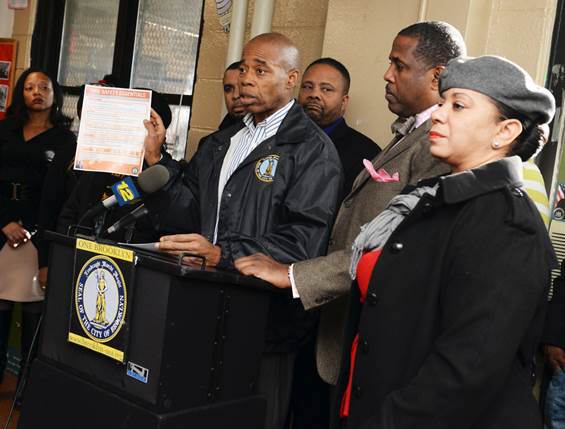Brooklyn Borough President Eric L. Adams and State Senator Kevin S. Parker yesterday circled Brooklyn’s state legislative wagons in kicking off a boroughwide campiagn to create Brooklyn’s first burn unit.
The initiative, which Adams has been championing ever since the tragic March 2015 fire that killed seven children in a Midwood home, took on new steam after last week’s fire at the New York City Housing Authority (NYCHA)’s Howard Houses in Brownsville took two lives including that of an infant.
According to the National Institutes of Health (NIH), advancements in health care have dramatically improved outcomes for patients in burn units as hospitals have developed better procedures to close wounds, reduce inflammation, prevent infection, and expedite the process of healing.
Noting that Brooklyn had 8,518 structural fires last year — 31 percent of the citywide total — Adams and Parker said called a burn center in the borough a health care investment in order to save Brooklynites’ lives when time is a critical factor.

“In the memory of every Brooklynite we have lost to a fire, especially those to burn- and smoke-related injuries, it is critical that we act,” said Adams. “The proximity of a burn unit translates into health care access that can mean the difference between life and death. We have the capability to invest in medical services that would keep families together and whole amid tragedies big and small. Now, we must turn pain into purpose and make a Brooklyn burn center a reality.”
A burn center provides all four phases of health care for burns, including treatment of wounds and surgery, interventions to prevent shock, rehabilitation services, and reconstructive surgery. Burn units treat a variety of burn types, such as the thermal burns sustained in a fire, chemical burns caused by common household cleaners and swimming pool chemicals, scald burns produced by hot liquids, as well as electrical burns that can also cause internal damage.
Currently, burn victims in the city are either sent to Columbia-Presbyterian Hospital in Manhattan, Jacobi Hospital in the Bronx, and Staten Island University Hospital North. Fire victims in Brooklyn with obvious burn damage are sent to one of those three locations, while those with bums that are not evident get treated initially at local hospitals, and are only then transported to other boroughs to receive care for their burns.
Cost estimates for the first year of operation for a new eight-bed burn unit, including build-out and operating costs, are approximately $14.5 million. Adams has committed $4.15 million from his Fiscal Year 2016 (FY16) capital budget to go toward the construction of a burn center in Brooklyn.

Meanwhile, Parker is spearheading the drive in Albany on the state level to lobby Governor Andrew Cuomo to allocate $10.44 million in the upcoming 2017-18 Executive Budget to make a burn center in Brooklyn possible. Joining them in the push are nearly all of the borough’s state lawmakers including State Senators Martin Malavé Dilan, Jesse Hamilton, Martin J. Golden, Roxanne Persaud, Diane Savino, and Daniel Squadron, as well as by Assembly Members Rodneyse Bichotte, Pamela Harris, Dov Hikind, Joseph R. Lentol, Walter T. Mosley, Felix Ortiz, N. Nick Perry, Diana Richardson, Jo Anne Simon, Latrice Walker, and Helene Weinstein.
“I stand firmly with Borough President Adams in urging Governor Cuomo to fund a burn unit in Brooklyn. With 2.6 million people living in our borough, it is our duty to ensure their safety by having the proper protocol in place in case of fire emergencies,” said Parker.
“Commuting fire victims outside of our borough for treatment is unacceptable; we can save more lives by having a burn unit in our borough to see that victims receive immediate care,” he added.






